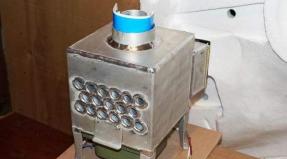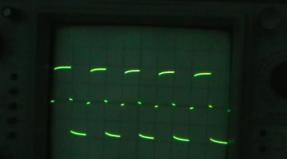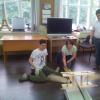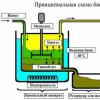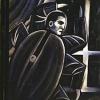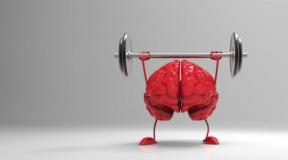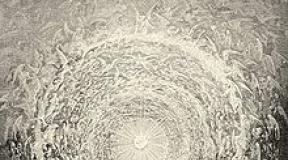Restoration of respiratory tract. Methods for restoring respiratory tract. Artificial respiration. Methods for artificial respiration (IVL). Emergency care for restoring respiratory tract without tools
Regardless of the condition of the respiratory tract, the respiratory volume should be from 6 to 8 / kg (significantly less recommended) and CDD should be from 8 to 10 breaths / min (much slower than recommended earlier, to avoid negative hemodynamic consequences).
Ensuring the maintenance of the upper respiratory tract
To reduce the obstruction of the respiratory tract caused by swelling of soft tissues, and provide an optimal position for the use of mask, ventilation and laryngoscopy, you need to throw the head back, thereby straightening the respiratory tract. You need to push the lower jaw by clicking on its corners.
Anatomical limitations, various anomalies or conditions caused by injury (for example, a neck fracture) may complicate the task due to the impossibility of using these techniques, but attentive attitude to the optimal position can improve the permeability of the respiratory tract, ventilation and relieve laryngoscopy.
Prostheses, as well as mucus, blood and other liquids can be removed from the oral cavity with a finger (in thoracic and small children, it is better not to use a finger, it is possible to free the oral cavity with the help of Madhill or suction forceps).
Hayimlich Reception (Podiafragmal Abdominal Shocks)
Hayymlich's reception consists of shocks at the top of the abdomen. The method is practiced in the unconscious state of the patient.
In the patient's position lying on his back the rescuer sits the top of the patient's knees and presses on the upper part of the abdomen, below the sword-shaped process movement from himself. To avoid damage to the structures of the chest and the liver, the rescuer should never put a hand on the moving process or chest. In both cases, 5 rapid jolts are made, and then the result is estimated.
When salvation, adult rescuer is behind the patient, clasping his hands for the belly. One fist is compressed and placed between the navel and the sword-shaped process. Another hand wars the fist, and the jolts are produced inside and up.
Humlich techniques can be used in older children. Nevertheless, children<20 кг (обычно < 5 лет) должно применяться очень умеренное давление, и спасатель должен встать на колени у ног ребенка, а не верхом.
In babies<1 года приемы Хеймлиха должны быть проведены лежа, головой вниз, Спасатель поддерживает голову пальцами одной руки. Ребенок может лежать на бедре спасателя вниз головой. Затем делается 5 толчков на грудь. Прием повторяют, пока не произойдет эвакуация инородного тела.
Breathing and breathing devices
If respiratory recovery does not occur after opening the respiratory tract and there are no devices artificial respiratory It is necessary to continue manipulation of existing means. A larger air can cause a stomach bloating and associated with the risk of aspiration.
Baked Valve Masks (Bag-Valve-Mask, BMV)
These devices consist of a respiratory bag (resuscitative bag) with a non-obverse valve mechanism and a soft mask for contact with facial tissues; When connected to the source O 2, they supply it from 60 to 100%. In the hands of experienced BVM practitioners provides adequate temporary ventilation in many situations, which allows you to win time. Nevertheless, when using a mask\u003e 5 min Air, as a rule, enters the stomach, and this requires its evacuation.
These devices do not support the loss of respiratory tract, so patients with soft tissue relaxation need rigid fixation in the desired posture and additional devices to maintain the airways. There are nasal tubes, tubes for oralogot. These devices cause vomit urge in patients in consciousness. The installation of the tubes should be carried out accordingly: not deeper than the distance between the patient's mouth and the angle of jaws.
Resuscitation bags are also used with artificial ventilation apparatus, incl. with endotracheal tubes. In children, bags have an adjustable safety valve, which limits the peak pressure in the respiratory tract (as a rule, from 35 to 45 cm H 2 O); Rescuers must control the valve to avoid accidental hypoventilation.
Gunted breathing masks (Laryngea Mask Airways LMA)
Gundy breathing masks or other intraclature breathing devices can be inserted into the rotoglot to prevent the respiratory tract soft fabrics And create an effective ventilation channel. As follows from the name, these devices are sealed along the entrance to the larynx (and not only by the face). These masks have become a standard method of salvation in situations where endotracheal intubation is impossible, as well as in some emergency situations. Complications include vomiting and vomit urge in patients who have a preserved vomit reflex, and which have gained excess ventilation.
There are many methods for installing these masks. Standard approach, it is a navalized mask opposite the solid sky (using a long finger) and past the root of the tongue, while the mask does not reach the alignment so that the tip then turned out to be at the top of the esophagus. After the mask was in the right position, it inflates.
Inflation mask up to half of the recommended volume. Although the Gundy Masks do not make the respiratory tract from the esophagus, they have some advantages compared to baggy valve masks: minimize the likelihood of a stomach bloating and ensure some protection against passive joining. New versions of these masks have a hole through which a small tube can be inserted into the stomach.
Unlike endotracheal tubes, the sanding masks are better adapted under the anatomy of a particular patient, because They are not so tough and able to adapt to the patient's anatomy. If the seal is insufficient, the mask pressure should be reduced; If this approach does not work, you should apply a larger mask.
Prolonged placement, recycling mask or both can compress the language and cause it swelling. In addition, if the patient is conscious, he needs to give minelaxants before making a mask (as, for example, for laryngoscopy), otherwise it may be suppressed and aspiration is possible when the effects are terminated.
Endotracheal tubes
The endotracheal tube is inserted directly into the trachea through the mouth or, less often, the nose. Endotracheal tubes have the ability to prevent air leakage using the cuff. Tubes with cuffs have traditionally been used in adults and children\u003e 12 years; However, now they are used in babies and children younger ageto limit air leakage (especially during transportation); Sometimes cuffs are not overestimated or inflated only to the degree needed to prevent leakage.
The endotracheal tube is the final method of ensuring air passability into the respiratory tract by the method of mechanical ventilation of comatose patients, those who need a long artificial ventilation lungs. Through the endotracheal tube, it is also possible to deliver drugs when the heart is stopped, but this practice is not welcome.
Installation, as a rule, requires high qualifications.
Other devices
There are other rescue ventilation devices, a hot tube or twin-lumen (for example, Combitube, King LT). These devices use two balloons to be fixed above and below the larynx, and have ventilation holes between balloons. Like a hot breathing mask, long-term accommodation and recycling can cause tongue swelling.
Trachea intubation
Orotrachial intubation is usually done using direct laryngoscopy, it is preferred with apnea in critical patients, as a rule, is carried out faster than the nickered intubation, which is intended for active, spontaneously breathable patients or in the case when the patient's oral cavity cannot be activated.
Before intubation
Receptions for the creation of respiratory tract and air of air in the airways are always preceded by intubations. As soon as the decision to intubate was made, preparatory activities begin:
- the patient is properly stacked;
- ventilation from 100% o 2;
- all necessary equipment is prepared (incl. suction devices);
- prepare necessary medications.
Ventilation from 100% O 2 healthy patients significantly extends safe time apnea (the effect is less in patients with severe heart failure).
Assessment of the complexity of laryngoscopy (for example, the definition of swelling of soft tissues by Mallampati Score) has a limited value in emergency situations. Practitioners rescuers should always be prepared to use an alternative method (for example, a gangny tube, bagpath-valve masks), if laryngoscopy does not work.
During the heart stop, the indirect heart massage should not stop at the time of intubation. You can intubate during a short pause between the chest excursions.
Suction equipment should be immediately used to clean the oral cavity from the selection and other content.
Pressure on the ring-shaped cartilage was previously recommended before and during intubation to prevent passive jumping. However, at present, according to the literary data, it is known that this maneuver can be less effective than it was thought to be threatened by a larynx crossing during laryngoscopy.
Preparations, incl. Sedatives, muscle mines, and sometimes wagolics are usually given to patients in consciousness or semi-conscious state to laryngoscopy.
Selection of tube and preparation
For most adults, you can use a tube with an inner diameter of\u003e 8 mm; These tubes are more preferable than smaller, because they have lower airflow resistance, fly off the excavation of the secret, ensure the passage of the bronchoscope and can make it easier with the removal from the IVL.
For babies and children\u003e 1 year, the hireless size of the tube is calculated by the formula: (patient's age + 16) / 4, thus, the 4-year-old must have (4 + 16) / 4 \u003d 5 mm the diameter of the endotracheal tube. The size of the tube must be reduced by 0.5 (1 pipe size) if the pipe with the cuff. Reference cards or devices, such as Broseel Tape, can quickly determine the corresponding laryngoscope blades size and endotracheal tube for babies and children.
For adults (and sometimes children), the hard stylet must be placed in the tube, with control, to stop the promotion of the style for 1 - 2 cm to the distal end of the intubation tube, so that the free tip of the tube remains soft. The stale is then installed right at the beginning of the distal end of the cuff; From this point on, the tube is bent up at an angle of about 35 °, reminding the shape of a hockey stick. This direct location of the tube relative to the cuff improves promotion and avoids the "stop" on the bundles during the passage of the pipe.
Technique setting
Successful intubation with the first attempt is important. Repeated laryngoscopy (\u003e 3 attempts) are associated with a high rate of hypoxemia, asphyxia and a heart stop. In addition to the correct formulation there are several other general principlesHaving crucial for success:
- Visualization of the Nastestrian.
- Visualization of deeper structures (ideally, voice ligaments).
- Further promotion is possible only if fixation is provided in the trachea.
The laryngoscope is carried out in the left hand, and the blade is inserted into the mouth and is used to displace the tongue up and to the side, opening the rear wall of the pharynx. Do not touch the cutters, also important the absence of excessive pressure on the structure of the larynx.
The importance of the identification of the nastestrian cannot be overvalued. It is a critical benchmark of the lower respiratory tract, and with the correct location of the Larngoscope blade, the Nadrostnik can reflect on the rear wall of the throat, where it merges with the rest of the mucous membrane and is lost in the mass of the discharge, which are invariably present in the patient's respiratory tract.
As soon as the host is found, the operator can raise it with the tip of the blade (typical direct approach) or promote the tip of the blade towards the pharynx (a typical approach with a curved blade). The success of an approach with a curved blade depends on the correct position of the tip of the blade and the direction of the lift. The rise of the nastestrian shows the rear structures of the larynx (slypalovoid cartilage, etc.), voice gap and voice ligaments. If the tip of the blade is too deep, the larynx landmarks can be left behind, and the dark, the round hole of the esophagus can be mistakenly taken for the open voice gap.
If the definition of structures is difficult, manipulating the lane with the right hand placed on the front surface of the neck, you can optimize the look of the larynx. Another way includes head rise above, eliminating the jaw, which improves direct visibility. These techniques are impractical in patients with potential injury of the cervical spine, and difficult when obesity. In the optimal position, voice ligaments are clearly visible.
If voice ligaments are not visible at least, the benchmarks of the rear wall of the pharynx and larynx should be viewed, and the tip of the tube should be visible when passing behind the cartilage. A manipulation specialist should clearly define laryngeal benchmarks to avoid potentially fatal esophageal intubation. If the rescuer is not sure that the tube will be in the trachea, the tube should not be inserted.
After the optimal visualization was achieved, the right hand inserts the tube through the larynx in the trachea (if the rescuer used the pressure on the front wall of the larynx on the right side, the assistant should continue this pressure). If the tube does not pass easily, turning the handset clockwise by 90 ° can help her go more smoothly through the rings of the trachea. Before removing the laryngoscope, the operators must confirm that the tube passes between the cords. The tube's depth corresponds to length, as a rule, from 21 to 23 cm in adults and 3 times shorter in children (for 4.0 mm endotracheal tube, 12 cm; for 5.5 mm endotracheal tube, 16.5 cm).
Alternative intubation devices
A number of devices and methods are increasingly used for intubation after unsuccessful laryngoscopy or as a basic means of intubation.
These devices include:
- Video Camera Larginoscope.
- Largeoscope mirror.
- Gunted breathing mask.
- Fiber optic optical styles.
- Adapters.
Each device has its subtleties. Working with this equipment people who have experience in a standard laryngoscopic intubation method should not assume that they can use one of these devices (especially after using muscle relaxants), without familiarizing them with them.
Video and mirror laryngoscopes allow you to explore the language and, as a rule, provide an excellent look of the larynx. Flexible fiber optic optical styles are very maneuverable and can be used in patients with unusual anatomy.
Compared to video and mirror laryngoscopes, fiber optic devices are harder to master and they are more susceptible to the presence of blood and highlights.
Flexible fiber optic volumes and optical styles are very maneuverable and can be used in patients with anomalous anatomy. Compared to video and mirror laryngoscopes, they are more difficult to master and they are more susceptible to the presence of blood and secretions, as well as they are capable of separating fabrics, and instead should be moved via open channels.
Adapters (usually these are so-called rubber bands or elastic vehicles) are semi-rigid styles that can be used when the visualization of the larynx is not optimal (for example, the native one is visible, but there is no opening of the larynx). In such cases, the introducer is transmitted along the lower surface of the native; From this point it is more likely to enter the tube in the trachea.
After installation
Stiletto is removed, and the cylinder cuff is infected with air with a syringe of 10 ml; Manometer is used to make sure that the pressure<30 см Н 2 O.
After inflating the cylinder, the placement of the pipe must be checked using various methods, incl.
- Inspection and auscultation.
- CO 2 detection.
- Confirmation of the absence of a tube in the esophagus.
- Sometimes chest radiography.
When the tube is installed correctly, manual ventilation should produce a symmetrical trick of the chest, the correct breathing noise of both lungs, and the lack of bouffaging in the top of the top of the abdomen.
Exhaled air must contain CO 2, not air from the stomach; The detection of CO 2 by the colorimetric method at the end of the exhalation of CO 2 in the device or signal capsophography confirms the placement of the trachea. When stopping the heart of CO 2, it cannot be detected even if the tube is properly placed. If the correct placement is confirmed, the tube must be fixed using the available device or adhesive tape.
Using the adapters, the endotracheal tube is connected to a resuscator bag through a tee, the moisturized O 2 or a mechanical fan is carried out there.
Endotracheal tubes can be shifted, especially in chaotic resuscitation situations, therefore the position of the tube must often be checked. If the breath is not held on the left, perhaps the tube is in the right bronchus, which is more likely than left-sided intense pneumothorax, but both options should be considered.
Non-Thale intubation
This method can be used in certain emergency situations, for example, when patients have seriously damage to the oral cavity or neck (for example, injuries, swelling, motion limit) that make a laryngoscopy difficult to determine. Historically, it has developed that, with native intubation, the use of muscle relaxants was inaccessible or prohibited and patients with tachipnee, hyperpnee and in a vertical position (for example, with heart failure) could literally breathe the tube. Nevertheless, the presence of non-invasive means of ventilation (for example, two-level positive pressure in the respiratory tract), the expansion of access and training of pharmacological benefits in intubation and new devices for ensuring the airway ventilation significantly reduced the use of nasal intubation. Additional problems with nasal intubation introduces incl. Sinusitis (often appear after 3 days). In addition, a sufficiently large diameter of the tube allows bronchoscopy (\u003e 8 mm).
To carry out unicundant intubation, use vesseloring drugs (for example, phenylephrine) and anesthetics (for example, benzocaine, lidocaine) on the mucous membrane of the nose and larynx to prevent bleeding and muffle the protective reflexes. Some patients may require sedatives, opiates and drugs with a local anesthetic effect. The tube can be placed using a simple anesthetic (for example, lidocaine). The nobility tube is then inserted to a depth of 14 cm (just above the entrance to the larynx in adults); At this point, the air movement must be heard auscultative. When the patient inhales, opening voice ligaments, the tube quickly shifts into the trachea. More flexible endotracheal tubes with an adjustable tip increase the likelihood of success. Some experienced resuscitative matters soften the tubes by placing them in warm water to reduce the risk of bleeding and facilitate the introduction.
Surgical support of breathing
If ventilation is impossible in the upper respiratory tract due to a foreign body or massive injury or if the ventilation cannot be achieved with other means, a surgical entrance to the trachea is required. Historically, surgery is a response to unsuccessful intubation. Nevertheless, surgical support of the respiratory tract requires an average of about 100 seconds from the initial cut; Other devices provide faster ventilation, and very few patients require emergency surgical support of respiratory tract.
Lower Laringotomy
Lower larynotomy is usually used for emergency surgical access, because it is faster and easier than tracheostomy.
The trachea is taken on the hook, it helps to keep the space open and prevent trachea retracting, while a small endotracheal tube (6.0 mm inner diameter) or a small tracheotic tube (4.0 SHI LEY preferably) moves through the surgical scene in the trachea.
Complications include bleeding, subcutaneous emphyms, pneumomediastinum and pneumothorax. Various modern devices make it possible to carry out quick surgical access to the pisnostechoid bunch and the promotion of the tube, which allows to achieve adequate oxygenation and ventilation.
Tracostomy
The tracheostomy is a more complex procedure, because the tracheal rings are very close to each other, and one ring, as a rule, should be almost completely removed to ensure the placement of the tube. The tracheostomy is preferably carried out in the surgeon operating room. The procedure has a higher frequency of complications than the coneepotomy and does not represent any advantages, is carried out in exceptional cases. However, it is a preferred procedure for patients who need long-term IVL.
Expressive tracheostomy is an attractive alternative for critical patients who cannot be moved to the operating room. This technique is "bedside", puncture of the skin is made and a tracheostomy tube is inserted through the extends. The help of fiber optic equipment is used to eliminate the perforation of the esophagus.
Complications of trachea intubation
Complications include:
- Direct injury of the esophagus.
- Food intubation
- Erosion or stenosis of the trachea.
The placement of the tube in the esophagus leads to a loss of time (ventilation is not achieved) and death or hypoxia and injury. The tube in the stomach causes tightening, which can lead to aspiration and difficulty visualization in subsequent intubation attempts.
Any translarician tube injures voice ligaments, sometimes an ulceration, ischemia, and their paralysis is possible. Signping stenosis can occur later (usually from 3 to 4 weeks).
Rarely meet the erosion of the trachea. It comes most often from excessively high pressure In the cuff. Rare and bleeding from large vessels (for example, a shoulder artery), and fistulas (especially the trachecope), and stenosis of the trachea. The use of a large diameter tubes, low pressure cuff with tubes of the appropriate size and measuring the pressure of the cuff (every 8 hours) to support it on<30 см Н 2 O, уменьшает риск некроза, но пациенты в шоке, с низким сердечным выбросом или с сепсисом остаются особенно уязвимыми.
Preparations for intubation
Patients without a pulse, with apnea or in a state of stunning can (and should) be intubated without pharmacological care. Other patients receive sedative and paralytic drugs to minimize discomfort and facilitate intubation (this is called fast sequential intubation).
Fast consistent intubation
Preliminary processing usually includes:
- 100% O 2.
- Lidocaine.
- Sometimes atropine or neuromuscular blocatars or both.
If time allows, patients must be placed 100% o 2 to 5 minutes; This measure can maintain a satisfactory oxygenation in previously healthy patients for up to 8 minutes. Nevertheless, the flow O 2 is very dependent on the pulse rate, pulmonary function, erythrocytes and many other metabolic factors.
Largeoscopy causes a sympathetic-indirect pressing reaction with an increase in heart rate and, may be an increase in intracranial pressure. To compact this answer, if time allows, some practitioners resuscitatively give lidocaine to sedation and muscle relaxation.
Children and adolescents often have a vagus response (pronounced bradycardia) in response to intubation, and, given this, atropine is introduced.
Some doctors use small doses of a neuromuscular blocker, such as this, in patients\u003e 65-70 years to prevent muscle beyciculation caused by large doses of succinylcholine. Facciculation can lead to muscle pain when awakening and cause short-term hypercalemia, however, the actual advantages of such prevention are not clear.
Sedation and anesthesia
Laryngoscopy and intubation is not convenient to spend in patients in consciousness, therefore the use of drugs short action With the sedative effect or combination of sedative and painkillers is mandatory.
This subframe, borrowed sleeping pills, may be a preferred drug. Fentanyl also works well and does not cause cardiovascular complications. Fentanyl is opioid and thus possesses painkillers, as well as sedative properties. However, at higher doses, the chest rigidity is possible. Ketamine is a dissociative anesthetic with pacemaker properties. As a rule, it is safe, but can cause hallucinations or strange behavior when waking. Tiopental and Methohexital are effective, but tend to cause hypotension and are used less frequently.
Mioroxation
The relaxation of skeletal muscles significantly facilitates intubation.
Succinylcholine depolarizing Miorosant central actionIt has the fastest start and a short time (from 3 to 5 minutes). Applications should be avoided in patients with burns, with traumatic dieting muscles\u003e 1-2 days, damage spinal cord, neuromuscular diseases, renal failure, or, possibly penetrating eye wounds. About 1/15,000 children (and less adults) have a genetic predisposition to malignant hyperthermia from succinylcholine. Sukcinylcholine should always be given with atropine (in children), because There may be pronounced bradycardia.
Alternative nonpolarizing muscle relaxants have a greater duration of action (\u003e 30 min), but also slow start, unless they are used in high doses that significantly prolong the relaxation. These drugs include Atrazuria, Miracurium, Rocuron, and Century.
Local anesthesia
The intubations of active patients (as a rule, not done in children) requires the anesthesia of the nose and pharynx, for this use: the drug-aerosol of benzocaine, tetrakain, butylamobenzoate (butamben), benzalconium. In addition, 4% of Lidocaine can be sprayed and inhaled through the mask.
The first event when conducting a patient in a critical condition is to ensure the loss of respiratory tract.
The upper obstruction of the respiratory tract is usually found in patients unconscious or in deep sedation. It can also meet in victims with the injury of lower jaws or muscles supporting the Gundorlotka. In these situations, the language shift is shifted to the upper respiratory tract when the patient is in the position lying on the back.
The risk of the upper obstruction of the respiratory tract caused by the weavest language can be significantly reduced by changing the position of the head, neck and lower jaw; using nasopharynx or rotochloric air ducts; or continuous positive pressure in the respiratory tract (CPAP).
Pulse oximetry (SPO2) significantly increased the ability to control the oxygenation of patients with the threat of obstruction of the respiratory tract. SPO2 monitors allow you to quickly recognize the occurrence of a critical situation associated with violation of oxygenation. SPO2 monitors are currently standard equipment at ambulance medical care and in the departments of intensive therapy.
Manual support of respiratory tract
The obstruction of the respiratory tract in unconscious patients can occur due to the spares of the language; However, research in the field of asphyxia during sleep and CPAP show that the concept of deformation of the respiratory tract, like a flexible tube, is more accurate.

The upper respiratory tract obstruction can manifest itself with snoring or string, but the patient with apnea often does not show an audible sign of the upper obstruction of the respiratory tract. Therefore, each unconscious patient potentially has the upper obstruction of the respiratory tract.
More than 30 years ago, Guildner compared the various methods to ensure the passability of the upper respiratory tract and found what methods such as heading the head, lifting the chin and the lower jaw extension were quite effective.
In modern manuals, there are still methods to "throw off the head / raise the chin" and put forward the jaw, but also describes the so-called " triple reception of Safara", Which is a combination of heading of the head, extension of the lower jaw, and the opening of the mouth.
It is widely recognized that only the jaw nomination (without thumbnails of the head) must be carried out in patients with suspected injury of the cervical spine, but this technique is sometimes ineffective and there is no evidence that it is more secure than the method "Back the head / raise chin".
In 2005, American Heart Association (AHA) determined that the manual methods for ensuring the resorts of the respiratory tract are safe with the accompanying immobilization of the cervical spine, but allocated the circumstance that all these interventions cause some movement in the cervical spine. And lifting the chin, and the extension of the lower jaw, as studied studies, cause some movement in the cervical spine.
In AHA recommendations for patients with suspicion of spine damage and difficulty respiratory tract, it is indicated that the methods of "throw off the head / lift chin" or the jaw extension (with the heading of the head) are performed and can be effective in order to free the respiratory tract. It is emphasized that maintenance of the airways and adequate ventilation is the most important priority in the treatment of the patient with suspicion of damage to the spine.
Despite the lack of evidence, the jaw nomination technique (without thumping the head) is quite effective and valuable. Of course, reasonably try to try, only push the jaw before using the "Back Head / Raise Chin" method in patients with a possible injury of the cervical spine.
Important, the addition of CPAP can reduce the obstruction of the respiratory tract when simple manual interventions fail.
To perform the reception "Back the head / raise your chin", place the middle fingers below the patient's chin. Press your chin to head and lift up. When the head leans back during this intervention, the neck will take a natural position. Press the pressure on only bony ledges of the chin, and not on the soft fabric of the submandibular area. Final step of this intervention - use thumbTo open the patient's mouth, while the head is tilted and the neck is straightened.

To perform the lower jaw extension, place the average or index fingers behind the angle of the lower jaw. Raise the bottom jaw up to the moment when the bottom cutters will be higher than the upper incisors. This intervention can be performed in combination with "Throw the head / lift chin" or with a neck, which is neutral during the current immobilization.

Obstruction of the respiratory tract of a foreign body
In 2005, International Consensus Conference On Cardiopulmonary Resuscitation and Emergency Cardiopulmonary Care appreciated the evidence of various methods to relieve the obstruction of the respiratory tract of the foreign body. They recognized the evidence to use chest jolts, abdominal jolts, and shocks / cotton from behind back.
However, the advantage of individual methods is not proved, which technique is better and must be used primarily. There are evidence that breast shocks can produce higher peak pressure in the respiratory tract than the reception of Heymlich.
The technique of subadiaphragmal abdominal jolts to relieve the obstruction of the respiratory tract was popularized by Dr. Henry Heimlich and is usually referred to as "". The technique is the most effective when a large piece of food closes the larynx.
Patient in consciousness position vertically. Surround your hands around the patient behind the patient, place the rays side of the compressed fist on the front abdominal wall, in the middle of the distance between the navel and the sword-shaped process. Take a fist with the opposite hand and make an internal and rising push abdominal cavity. Successful intervention will cause the removal of the foreign body from the respiratory tract of the patient of the force of air emerging from the lungs.

Abdominal shocks can also be performed in patients in the unconscious state lying on the back. To do this, kneel to the pelvis of the patient lying with the trapped head. Put the bases of the palms on the upper department of the abdominal cavity, at the same point as in vertical technique. Cut up inside, up. 
Relative contraindication for performing Hamelich is pregnancy and patients with convex belly. The potential risks of subadiaphraggmal jigsaws include a gastric gap, esophageal perforation, and mesenteric damage. In pregnant women, Heimlich is performed with breast overlapping.

During cardiovascular Resuscitation The obstruction of the respiratory tract of the foreign bodies will be stopped by a breast compression (beats on the back at an inverted baby). The mechanism of action is the same as typical jolts to remove the foreign body, squeeze the air from the lungs.

Some authors believe that breast compression can create higher peak pressure in the respiratory tract than the reception of Heymlich. The combined (simultaneous) breast compression and subiaphragmal abdominal push can make even higher peak respiratory tract pressure and this option should be viewed when standard methods fail.
Boots-cotton on the back are often recommended for babies and small children with the obstruction of the respiratory tract of the foreign body. Some authors argued that the back strikes can be dangerous and can promote foreign bodies deeper into the respiratory tract, but there is no convincing evidence of this fact.
As for other sources, it is assumed that the beats on the back are quite effective. However, no convincing data proves that impacts on the back are more or less effective than the abdominal or chest joll. Beats on the back can produce a more explicit increase in the pressure in the respiratory tract, but at a shorter period of time than other methods.
In the recommendations of AHA, it is proposed to use beats on the back in babies and small children in the downstream position. AHA does not recommend applying an abdominal push in babies, because infants have a higher risk of applying non-heroed injury. From a practical point of view, the back strikes should be carried out in patients in the position of the head, which is easier to reach the babies than in large children.
Suction
 Giving the patient the correct position and the use of manual methods is often not enough to achieve the full revealed condition of the respiratory tract. Continuing bleeding, vomiting, and the presence of solid particles often require aspiration.
Giving the patient the correct position and the use of manual methods is often not enough to achieve the full revealed condition of the respiratory tract. Continuing bleeding, vomiting, and the presence of solid particles often require aspiration.
There are several types of aspiration tips. Big diameter dental-Type The tip of the suction is the most effective for purifying vomit masses from the upper respiratory tract, because it is least subject to hard particle.
Tip of suction tonsil-Tip. It can be used to clean the respiratory tract from bleeding and secretory discharges. Its rounded tip is less traumatic to mild tissues; However, its diameter is not large enough for effectively absorption of vomit.
Aspiration tips DENTAL-TYPE, for example, Hi-D Big Stick SUCTION TIP Must be prepared and easily accessible by the patient's bed in the departments of intensive therapy. The large diameter of the tip allows you to quickly clean the oral cavity from the vomit, bleeding and secretory seals.
 Keep the aspiration equipment connected and ready to use; All participating emergency need to know how to use it. No certain contraindications for aspiration of respiratory tract do not exist.
Keep the aspiration equipment connected and ready to use; All participating emergency need to know how to use it. No certain contraindications for aspiration of respiratory tract do not exist.
The arrangement of the tip as close as possible to the aspirator reduces the possibility of clogging with solid particles. The tip installed directly on the endotracheal intubation tube was described, the use of this device allows you to effectively aspirate during intubation.
Complications of aspiration can be avoided, waiting for the problem and ensuring a careful procedure. Nasal suction is rarely required, mostly in infants, because most of the obstruction of the respiratory tract in adults meets in the mouth and the rotoglot.
Avoid extended suction, as this can lead to significant hypoxia, especially in children. Do not exceed 15-second intervals for aspiration and give an additional O2 before and after the procedure.
Perform aspiration under visual control or with a laryngoscope. Succession blind can lead to injury to soft tissues or convert partial obstruction in complete obstruction.
Installation of the air duct
After the respiratory tracts were disclosed using manual methods and aspiration, the installation of the air duct, the rotoglotter and nasopharynknaya, can alleviate spontaneous breathing and mask ventilation with a bag of AMBU.
In patients with oppression of consciousness, after stopping the use of manual methods, hypoxia may develop due to the recurrence of obstruction. Inhalation O2 and nasochloric air duct prevent similar outcomes.
The simplest and most widely available air ducts are rotoglotting and nasochloric air ducts. Both are designed to obstruct the language to overlap the respiratory tract, pressing to the rear wall of the pharynx. Air ducts can also prevent teeth compression.
The rotoglotter air duct can be inserted by any of two techniques:
- insert the air duct in an inverted position along the patient's solid sky, then turn it 180 ° and move it into the final position along the patient's language, the distal end of the air duct must lie in the altarlot.
- long open your mouth, use a language holder to move the language, and then simply advance the air duct into the rotoglot. No rotation is required when the air duct is administered to this method. This technique may be less traumatic, but takes more time.
The nasopharynx duct is very easy to install. Air duct to promote in the nostril along the bottom of the nasal passage in the direction of the nape, not cranitually. Protect completely until the external tip of the air duct does not reach the nose hole.
And rotoglotting and nasopharynx ducts are available in various sizes. To determine the correct size for the air duct, attach it to the patient's face. Proper size The rotoglotter air duct will extend from the corner of the mouth to the ear of the ear. The correct size of the nasopharynx duct will extend from the tip of the nose to the ear of the ear.

The nasopharynx ducts are better transferred to patients with oppression of consciousness, the appearance of vomiting is less likely.
The nasopharynk air duct can cause nose bleedHis installation is dangerous in patients with significant fractures of facial bones and fractures of the base of the skull.
The rotoglotter air duct can cause vomiting when it is placed in patients with intact vomit reflex. The rotoglotter air duct can also cause the respiratory tract if the tongue is pressed to the rear wall of the pharynx during its installation.

Robert F. Reardon, Phillip E. Mason, Joseph E. Clinton
The causes of the mechanical disorders of the upper respiratory tract are the stock of the tongue to the rear wall of the pharynx in the unconscious state (coma); accumulation of blood, mucus or vomit in the oral cavity; Foreign bodies, edema or spasm of the upper respiratory tract.
In the case of full obturation of the air paths while trying to suffer inhales rib cage And the front surface of the neck. It is deadly dangerous not only complete, but also a partial obturation of airways, which is the cause of deep hypoxia brain, edema of the lungs and the secondary apnea as a result of the depletion of the respiratory function. It must be remembered that the attempt to put the pillow under the head can contribute to the transition of partially obturation of the respiratory tract in full and lead to death especially when the root of the language.
The victim must be put on the back on a rigid surface, after which it is used to apply the triple reception of the Safar, following the following steps:
1. Back the head of the victim back. One hand raises the neck from behind, and the other press on top down on the forehead, throwing the head. In most cases (up to 80%), the permeability of the respiratory tract is restored. We must not forget that the patient's head of the patient back during damage to the cervical spine is contraindicated.
2. Pull the lower jaw forward. This reception is carried out by pulling out the corners of the lower jaws (two hands or for the chin with one hand).
3. Open and inspect your mouth. When blood, mucus, dumping masses that interfere with breathing are found in the mouth and sip, it is necessary to remove them using a marlevary napkin or a handkerchief on the finger. With this manipulation, the patient's head turns the side. Although such an admission allows you to clear only the upper departments of the airways, it must be performed.
All listed actions must be made in less than 1 min. They exhale the patient's mouth, watching the tricky of the chest and passive exhalation. If the respiratory tract is undergoing and the air penetrates into the lungs, IVL continues. If the chest is not inflated, it can be assumed that a foreign body is present in the respiratory tract. In this case, it is necessary:
1) try to remove the foreign body II or II and III fingers entered into the thread to the base of the tongue in the form of a tweezers;
2) in the patient's position on the side to make four or five strong shocks with palm between the blades;
3) in the position of the victim on the back to make several active jolts into the epigastria area from the bottom upward in the direction of the chest.
The last two techniques cause an increase in the pressure in the respiratory tract, which contributes to the pushing of the foreign body.
If the victim is still in consciousness, both of these techniques are performed in the standing position.
When providing medical care, it is important to be able to not only eliminate asphyxia, but, if possible, prevent its occurrence. The greatest danger of asphyxia threatens victims, which are unconscious (coma), which have bleeding into the oral cavity, vomiting, the spares of the language can lead to death. If there is no possibility to be constantly near the victim and follow its condition, it is necessary:
1) Rotate the victim or with severe injuries to his headset and fix in this position (this will give the opportunity of blood or the vomiting masses to flow out of the oral cavity);
2) stretch out of the oral cavity and fix the language, proof by its pin or ligabling.
Language breeding is much more dangerous possible consequences This manipulation carried out without compliance with the rules of aseptics. You can use S-shaped ducts that prevent obturation and hold the root of the language. The air duct is introduced by rotational motion. However, the air ducts are easily shifted, so they need to constantly observe.
Manual receptions of recovery of respiratory tract.
Throwing heads.
The mechanism of this simple manipulation comes down to the fact that when the head is folding, the root of the tongue rises above the rear wall of the pharynx of the inclination of the ligament apparatus.
Indications:
1. First aid with a threatening impaired respiratory tract.
2. Help the breath in patients who are under the action medicinesDepressing the CNS.
3. Reducing the obstruction of the respiratory tract with soft tissues (spare back language).
Contraindications for heading of the head:
1. Suspicion of damage to the cervical spine.
2. Down syndrome (due to incomplete compliance and incomplete displacement of cervical vertebrae C1-C2).
3. The battle of the cervical vertebrae.
4. Pathology of the cervical spine (ankylosing spondyloarthritis, rheumatoid arthritis).
Anesthesia:need not.
Equipment:not necessary.
Patient position:lying on the back.
Admission technique:
1. In the presence of the above contraindications, use only the output method of the lower jaw.
2. Take it under the neck of the injured hand, the side of the resuscator location relative to the injury body.
3. Another hand is put on the forehead so that the edge of the palm is at the beginning of the scalp.
4. Produce a single-time movement of hands, which throws the head back in the Atlantooccipal joint, leaving the mouth closed at the same time; The head remains in neutral position.
5. Raise the chin, while putting the rise and extending the sub-band bone from the rear wall of the throat.
NOTA BEPE! You should not turn the navice and sharply throw it.
Quite moderate extension of the cervical spine.
Lowering the lower jaw.
The mechanism of this manipulation complements the head of the head of the head, which makes it easier and improves the lingerie root summing over the rear wall of the throat due to the ligament apparatus of the larynx.
Indications:the same.


Fig. 1. Stages of ensuring respiratory tract:
A - Opening of the mouth:
1 - crossed fingers,
2 - the grip of the lower jaw, using the strut;
Triya reception:
1 - thumbs Press on the chin, shifted the jaw down,
2 - three fingers are on the corners of the jaw, and put it forward,
3 - head intake increases the permeability of the respiratory tract;
B - Cleansing the oral cavity:
1 - finger,
2 - with a suction.
Contraindications:pathology of maxillofacial joints, ankylosis, rheumatoid arthritis).
Anesthesia:need not.
Equipment:not necessary.
Patient position(See Fig. 1): lying on the back.
Technics:
1. Lightly open your mouth, carefully press on the chin with thumbs.
2. Squeeze the lower jaw with your fingers and bring it up: lower teeth At the same time should be on the same level with the upper teeth.
3. Mainly use the bimanual method: with a decrease in the effort, the elastic force of the mandibular joint capsule and the chewing muscle will pull the lower jaw back to the joint.
Complications and their elimination:when performing manual techniques in children under the age of 5 years, the cervical spine can cross up, the pushing the back wall of the larynx to the tongue and the native. At the same time, obstruction may increase, therefore, children have better resorts of the respiratory tract provided with a neutral position of the head.
Note:
The optimal method of recovery of the airways is " triple "Reception P. Safar, which consists in one-step backstage of the head, the removal of the lower jaw and the opening of the mouth.
Technics:
1. Resuscator becomes the head of the injured (patient).
2. The resuscator has his own hands so that III, IV, V fingers are at the angles of the lower jaw from the sides of the same name, and the edges of the palms - at the beginning of the scalp on the head at the temples.
3. The index fingers are located under the bottom lip, and the thumbs are above the top.
4. At the same time, moderate heading of the head and opening of the mouth is made by raising the lower jaw.
Note:
After performing the "triple" reception, it is necessary to clean the oral cavity from foreign languages, mucus, vomiting masses. If there is no equipment for cleansing the oral cavity and pharynx, it can be made with a finger wrapped with gauze or bandage. The sputum that is usually accumulated in retrofaring tow, easy to remove suction, having spent the catheter to the throat through the mouth or nose.
You can use a conventional rubber pear.
The maintenance of respiratory tract can also be used by the use of trachea intubation, stage stage, laryngeal mask and other devices.
Indications:
1. Long stay of the victim in an unconscious state.
2. The need to exemplate the hands of resuscitation to fulfill other activities.
3. The state of the coma.
Restoration of the airways is the most important stage, without which it is not mentally effective to perform an effective election.
The reasons for the impairment of the respiratory tract may be different: the transshipment of the language, the presence of mucus, sputum, vomiting mass, blood, foreign bodies. The choice of the recovery method of respiratory tract depends on the level of obstruction and the circumstances of the obstruction. On the street, in transport, not the place of incident, the catastrophe has to do with minimal means.
Algorithm Action:
1. Make the victim on the back for a rigid basis.
2. Disseminate shy clothes.
3. Folders of both hands capture the lower jaw of the victim near the ears and shift the jaw forward and up so that the bottom and the upper teeth are located in the same plane.
4. Large fingers, shift the lower jaw and open the affected mouth (these techniques are used when weave the language).
5. Turning the head of the victim on the side, fingers, wrapped with a nasal scarf or gauze, circular movements examine the oral cavity and clean it from mucus, vomit, blood, sputum, etc.
6. In the presence of foreign bodies in the oral cavity 2-3 fingers, like a tweezers, try to capture and remove it (if possible). To remove foreign bodies from other respiratory tract departments, use one of the receptions described above.
7. Sit down left Under the neck, and put the right on the forehead and tighten the head of the victim back.
Attention!If you suspect the fracture of the spine at the victim, the head back is not recommended.
8. Under the blades to put the roller. In this position, the tongue rises up and departs from the rear wall of the pharynx, thus eliminating the obstacle to the air path, and the absorption of the respiratory tract is the largest. These activities are necessary because in the position on the back and relaxed muscles, the lumen of the respiratory tract decreases, and the root of the tongue closes the entrance to the trachea. Making sure that the respiratory tract is free, proceed to IVL.
Artificial ventilation of light IVL must be carried out in cases where breathing is absent or violated to such an extent that it threatens the life of the victim.
IVL is carried out by actively blowing air into light victims.
Task IVL - replace the lost or weakened ventilation volume of pulmonary olviol. IVL can be carried out in several ways. The easiest of them is the IVL "mouth in the mouth" or "mouth in the nose".
Algorithm Action:
1. Provide the airway passability.
2. Large and index fingers on the forehead of the victim, hold down the nose and spend IVL by the way "mouth to mouth". 3. Make a deep breath.
4. Tightly pressing his mouth to an isolated marlevary napkin (or a nasal handkerchief) of the victim's mouth, make a deep energetic exhalation in its respiratory tract. Try to blow a sufficient amount of air in order to have a good chest.
5. Then remove it, holding the head of the victim in the crowned position, and let the passive exhale.
6. As soon as the chest drop and accept the initial position, the cycle repeat.
Remember!The duration of the breath must be shorter than the exhalation by time 2 times. The frequency of fading on average should be 12-14 per minute.
When conducting an IVL by the way "from the mouth to the nose", the position of the victim is the same, but at the same time its mouth is closed and at the same time shift the lower jaw forward to prevent the vigorial language. Plugs produce through the nose of the victim, isolated with a marral napkin or a nose handkerchief.
Remember!If the victim has removable prostheses, when conducting an IVL, they are left in the mouth for a more dense contact with the mouth of the rescuer. When carrying out an IVL through the tracheosid head, the victim is not infringement.
Efficiency criterion IVL
1. Synchronous grinding chest expansion.
2. Listening and the feeling of motion of a mounted jet when inhaling.
Complications of IVL
Air entering the stomach, resulting in a swelling of the nadium region. This can lead to a passive pussy of the contents first in the mouth of the stomach, and then into the respiratory tract.
